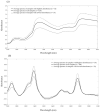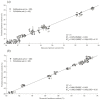Determination of Moisture and Protein Content in Living Mealworm Larvae (Tenebrio molitor L.) Using Near-Infrared Reflectance Spectroscopy (NIRS)
- PMID: 35735897
- PMCID: PMC9224910
- DOI: 10.3390/insects13060560
Determination of Moisture and Protein Content in Living Mealworm Larvae (Tenebrio molitor L.) Using Near-Infrared Reflectance Spectroscopy (NIRS)
Abstract
Yellow mealworm larvae (Tenebrio molitor L.) are a sustainable source of protein for food and feed. This study represents a new approach in analyzing changes in the nutritional composition of mealworm larvae using near-infrared reflectance spectroscopy (NIRS) combined with multivariate analysis. The moisture and protein content of living larvae were scanned with a near-infrared spectrometer using wavelengths from 1100 to 2100 nm. Different feeding groups with varying moisture sources and amount and the difference between low (50%) and high (75%) humidity were tested, and the influence on larval moisture and protein content was measured. A calibration was developed, with modified partial least squares as the regression method. The NIR spectra were influenced by the moisture and protein content of the larvae, because the absorbance values of the larval groups differed greatly. The coefficient of the determination of calibration (R2c) and prediction (R2p) were over 0.98 for moisture and over 0.94 for protein content. The moisture source and content also had a significant influence on the weight gain of the larvae. Consequently, significant differences in protein content could be determined, depending on the water supply available. With respect to wet weight, the larvae moisture content varied from 60 to 74% and protein content from 16 to 24%. This investigation revealed that with non-invasive NIRS online monitoring, the composition of insects can be continuously recorded and evaluated so that specific feeding can be carried out in the course of larval development and composition.
Keywords: Tenebrio molitor; chemometrics; edible insects; near-infrared spectroscopy; nutritional composition; rapid method; water supply.
Conflict of interest statement
The authors declare no conflict of interest.
Figures


Similar articles
-
Influence of Dietary Protein Content on the Nutritional Composition of Mealworm Larvae (Tenebrio molitor L.).Insects. 2023 Mar 6;14(3):261. doi: 10.3390/insects14030261. Insects. 2023. PMID: 36975946 Free PMC article.
-
Near-Infrared Reflectance Spectroscopy for Quantitative Analysis of Fat and Fatty Acid Content in Living Tenebrio molitor Larvae to Detect the Influence of Substrate on Larval Composition.Insects. 2023 Jan 23;14(2):114. doi: 10.3390/insects14020114. Insects. 2023. PMID: 36835684 Free PMC article.
-
Analysis of the Composition of Different Instars of Tenebrio molitor Larvae using Near-Infrared Reflectance Spectroscopy for Prediction of Amino and Fatty Acid Content.Insects. 2023 Mar 23;14(4):310. doi: 10.3390/insects14040310. Insects. 2023. PMID: 37103125 Free PMC article.
-
Mealworm (Tenebrio molitor Larvae) as an Alternative Protein Source for Monogastric Animal: A Review.Animals (Basel). 2020 Nov 8;10(11):2068. doi: 10.3390/ani10112068. Animals (Basel). 2020. PMID: 33171639 Free PMC article. Review.
-
[Application of near infrared reflectance spectroscopy to predict meat chemical compositions: a review].Guang Pu Xue Yu Guang Pu Fen Xi. 2013 Nov;33(11):3002-9. Guang Pu Xue Yu Guang Pu Fen Xi. 2013. PMID: 24555369 Review. Chinese.
Cited by
-
Exploiting Agri-Food Waste as Feed for Tenebrio molitor Larvae Rearing: A Review.Foods. 2024 Mar 27;13(7):1027. doi: 10.3390/foods13071027. Foods. 2024. PMID: 38611333 Free PMC article. Review.
-
The distribution of rennet activity between the cheese aging process and whey is not influenced by the association of enzymes with caseins.Heliyon. 2024 May 31;10(11):e32263. doi: 10.1016/j.heliyon.2024.e32263. eCollection 2024 Jun 15. Heliyon. 2024. PMID: 38867957 Free PMC article.
-
Influence of Dietary Protein Content on the Nutritional Composition of Mealworm Larvae (Tenebrio molitor L.).Insects. 2023 Mar 6;14(3):261. doi: 10.3390/insects14030261. Insects. 2023. PMID: 36975946 Free PMC article.
-
Near-Infrared Reflectance Spectroscopy for Quantitative Analysis of Fat and Fatty Acid Content in Living Tenebrio molitor Larvae to Detect the Influence of Substrate on Larval Composition.Insects. 2023 Jan 23;14(2):114. doi: 10.3390/insects14020114. Insects. 2023. PMID: 36835684 Free PMC article.
-
Analysis of the Composition of Different Instars of Tenebrio molitor Larvae using Near-Infrared Reflectance Spectroscopy for Prediction of Amino and Fatty Acid Content.Insects. 2023 Mar 23;14(4):310. doi: 10.3390/insects14040310. Insects. 2023. PMID: 37103125 Free PMC article.
References
-
- Grafton R.Q., Daugbjerg C., Qureshi M.E. Towards food security by 2050. Food Secur. 2015;7:179–183. doi: 10.1007/s12571-015-0445-x. - DOI
-
- Belluco S., Losasso C., Maggioletti M., Alonzi C.C., Paoletti M.G., Ricci A. Edible Insects in a Food Safety and Nutritional Perspective: A Critical Review. Compr. Rev. Food Sci. Food Saf. 2013;12:296–313. doi: 10.1111/1541-4337.12014. - DOI
-
- Dobermann D., Swift J.A., Field L.M. Opportunities and hurdles of edible insects for food and feed. Nutr. Bull. 2017;42:293–308. doi: 10.1111/nbu.12291. - DOI
-
- van Huis A., Oonincx D.G.A.B. The environmental sustainability of insects as food and feed. A review. Agron. Sustain. Dev. 2017;37:293–308. doi: 10.1007/s13593-017-0452-8. - DOI
-
- Patel S., Suleria H.A.R., Rauf A. Edible insects as innovative foods: Nutritional and functional assessments. Trends Food Sci. Technol. 2019;86:352–359. doi: 10.1016/j.tifs.2019.02.033. - DOI
Grants and funding
LinkOut - more resources
Full Text Sources
Other Literature Sources
Miscellaneous

